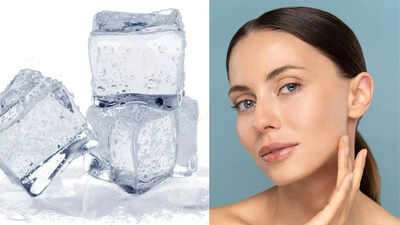Facial icing, a practice also known as skin icing or cryotherapy, is making waves on social media, touted for its supposed therapeutic and aesthetic advantages. Proponents claim it can alleviate acne, reduce swollen eyes, and address various other skin concerns.

However, despite the established use of cold therapy for injury treatment and pain relief, the scientific community has yet to provide substantial evidence supporting the claimed benefits of icing for facial skin. While anecdotal evidence and personal testimonies abound, further research is necessary to validate its efficacy.
According to experts, there are two common methods for applying ice to the face:
Regardless of the chosen technique, gently massage the face with the ice in slow, circular motions for approximately 1 to 2 minutes. It's crucial to avoid prolonged direct contact between the ice and skin, as extended exposure may lead to irritation.
This circular massage can be performed once daily, targeting specific areas such as:
Before incorporating ice facials into your routine, consulting a healthcare or skincare professional is recommended. Consider the following tips:
Regularly replace the ice and wrapping to prevent bacterial contamination. Remember, facial icing should complement, not replace, your existing skincare regimen.
The rising popularity of ice facials can be attributed to several factors:
Improper or prolonged facial icing can lead to adverse effects, including:
Individuals with pre-existing health conditions like diabetes or Raynaud's syndrome should exercise caution or consult a physician before attempting facial icing, as it may exacerbate sensitivity or nerve-related issues.
Facial icing offers several potential benefits:
While these potential benefits are promising, further research is necessary to validate the direct effects of facial icing on puffiness and acne.
Disclaimer: The content provided is based on general information and does not replace medical or dermatological advice. Individual skin types and conditions vary. Always consult a dermatologist before trying new skincare routines.
Newer articles
Older articles
 Hetmyer's Heroics: Orcas Stun MI New York with Last-Ball Six in Record-Breaking MLC Chase
Hetmyer's Heroics: Orcas Stun MI New York with Last-Ball Six in Record-Breaking MLC Chase
 Android Users Face Critical Security Risks: Update Your Devices Now, Warns Government Agency
Android Users Face Critical Security Risks: Update Your Devices Now, Warns Government Agency
 Greg Chappell Hails Rishabh Pant's "Revolutionary" Batting, Likens Him to Gilchrist
Greg Chappell Hails Rishabh Pant's "Revolutionary" Batting, Likens Him to Gilchrist
 Dog-Sized Dinosaur Fossil Unearths New Insights into Prehistoric Life Alongside Giants
Dog-Sized Dinosaur Fossil Unearths New Insights into Prehistoric Life Alongside Giants
 West Indies Captain Chase Slams Umpiring After Test Loss, Demands Accountability
West Indies Captain Chase Slams Umpiring After Test Loss, Demands Accountability
 IRCTC's AI Chatbot, AskDisha 2.0, Streamlines Train Ticket Booking, Refunds & Information
IRCTC's AI Chatbot, AskDisha 2.0, Streamlines Train Ticket Booking, Refunds & Information
 Freestyle Chess India Event Scrapped Due to Sponsorship Issues; Carlsen Absence Confirmed
Freestyle Chess India Event Scrapped Due to Sponsorship Issues; Carlsen Absence Confirmed
 Moto G54 Gets Significant Price Drop in India: Check Out the New Affordable Price Tag
Moto G54 Gets Significant Price Drop in India: Check Out the New Affordable Price Tag
 New Zealand Cricket Announces Packed 2025-26 Home Schedule Featuring Australia, England, West Indies & South Africa
New Zealand Cricket Announces Packed 2025-26 Home Schedule Featuring Australia, England, West Indies & South Africa
 Converting JPG to PDF: A Comprehensive Guide for Preserving Image Quality and Ensuring Accessibility
Converting JPG to PDF: A Comprehensive Guide for Preserving Image Quality and Ensuring Accessibility